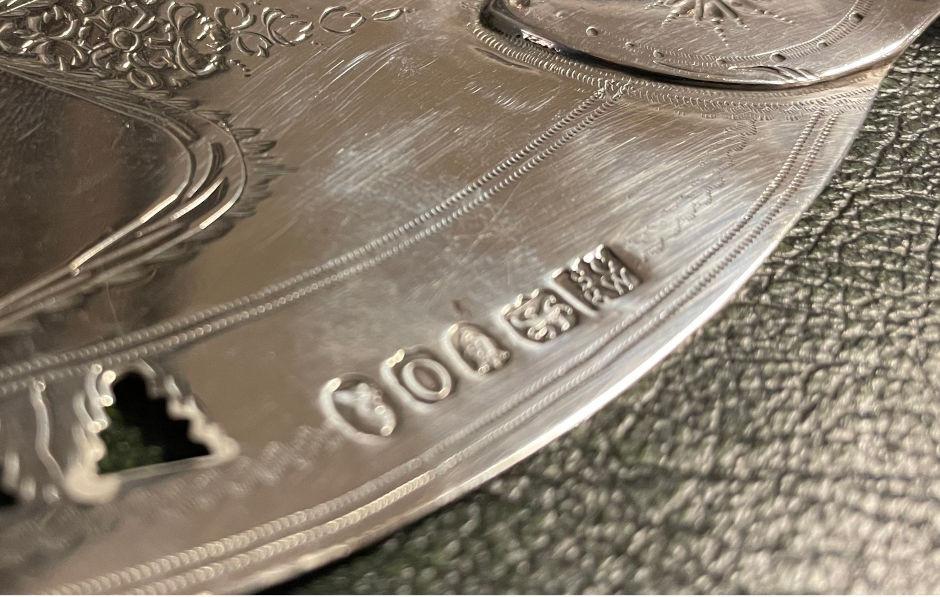
In their purest forms, gold, silver and platinum are too soft and are unworkable, but when combined with copper or another metal to create an alloy, they become strong enough to be worked by a jeweller or craftsman. As the precious metal content cannot be determined by eye, there has always been the opportunity to significantly reduce the precious metal content for profit, and perhaps the earliest consumer protection came in the form of a statute decreed by Edward I requiring that all silver articles must meet the sterling silver standard (92.5% pure silver) and must be assayed as such by ‘guardians of the craft’ who would then mark the item with a leopard’s head.
You are watching: Silver hallmarks: how to tell if your silver is antique
Before you can attempt to read silver hallmarks, however, or date an item, it is important to know where to look for hallmarks.
Where to find silver hallmarks on cutlery
Silver spoons – the hallmark will usually be on the reverse of the handle, just below the bowl of the spoon.
Silver knives – knives will be hallmarked on the collar, or ferrule, that goes round the handle.
Silver forks – look for the hallmark on the wider portion of the fork, near the shoulders and below the tines.
Where to find silver hallmarks on larger pieces
Silver dishes, bowls, teapots and trays – large pieces like these will be hallmarked on the base.
Silver decorative pieces – silver candlesticks, figures and vases will also be hallmarked on the base if the area is large enough. If not, look for the hallmark in an inconspicuous area.
Where to find silver hallmarks on smaller items
Silver dresser sets and their associated items (hairbrushes, mirrors etc.) will be hallmarked on the underside or on the handles.
Nearly all silver items that have been made in England, Scotland and Ireland in the past five hundred years will have a hallmark consisting of 4 or 5 symbols stamped into the metal.
The silver standard mark
Read more : The Decorative Antiques & Textiles Fair – 24-29 January 2023
Standard marks indicate that the silver content is 925 parts of pure silver per 1000 and show where the silver item was made. For English silver the standard mark is a lion passant, while Scottish silver bears the mark of a thistle (Glasgow) and lion rampant (Glasgow and Edinburgh from 1975). Irish silver has a crowned harp mark. For a brief period between 1696-1720, the standard for silver fineness was raised from 925 parts per 1000 to 958.4/1000, and for those 24 years, the standard mark was a Britannia mark. If your silver item does not have one of these standard marks, it could be silver plate or silver from abroad.
Once you have established the standard mark, look for the town mark.
The town mark
The town mark or mark of origin shows the assay office that verified the silver item. There are various town marks but those of interest to the collector of antique silver are as follows:
London 1696-1719 – a lion head erased
London Pre-1820 – a leopard’s head crowned
London 1821-present day – a leopard’s head uncrowned
Birmingham – an anchor
Sheffield 1773-1975 – a crown
Sheffield 1975-present day – a Tudor rose
Chester 1784-1962 – a sword with three wheat sheaves.
Read more : JEROEN MARKIES ART DECO
Edinburgh – a castle
Glasgow 1681-1963 – a tree, fish and bell
Exeter 1701-1856 – a castle with three towers
York 1710-1856 – five lions passant on a cross
Newcastle Upon Tyne 1658-1883 – three castles
Dublin – a crowned harp, the same as the standard mark for Ireland, which was only applied once
The date letter
Once you have established the town mark for the silver, you can turn your attention to the date letter. Each assay office used a unique date chart with each year represented by a letter of the alphabet. The letters vary in font style, upper/lower case and background shape, according to the assay office and not all assay offices changed the letter used at the same time of year, nor were they all using the same letter at the same time. A uniform dating system was introduced with the UK Hallmarking Act (1973). Date letter charts for each of the current assay offices can be seen in our blog, Identifying antique gold hallmarks – an in-depth guide.
The duty mark
First used in England in 1784, and lasting until 1890, the duty mark takes the form of the prevailing monarch’s head and indicates that the correct duty has been paid on the piece with the mark. Any pieces featuring two King’s head can be dated specifically to a 9-month period from July 1797 when the duty was doubled. Dublin also had a special duty mark (Hibernia) from 1730-1806.
The maker’s mark
The maker’s mark was unique to the silversmith presenting the piece for verification at the assay office and was usually their initials set in a unique shape.
Identifying silver hallmarks can be daunting at first but there are several reference books available to help and of course our specialist silver dealers at Hemswell are always happy to offer help and advice. Whether you prefer early Georgian silver or pieces from the Arts and Crafts aesthetic movement, our antique silver for sale will have something that you will love and cherish forever.
Source: https://antiquewolrd.com
Categories: Antique News

